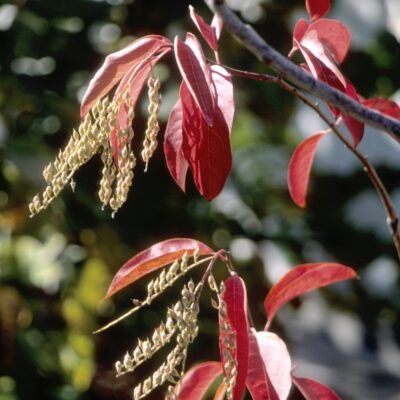Garden Plant: Sourwood
Product Description: Sourwood

Excellent Fall Color Ornamental Sourwood Honey Tree
- Incredible Fall Color Display on Large Leaves
- Eye-catching Summer Flowers Look Like Lily of the Valley
- Outstanding Shade Tree
- Wonderful Architectural Presence in the Landscape
- Deeply Furrowed Bark Adds Texture and Winter Interest
- Long Lived Selection
- Native to North America
- Valuable Sourwood Honey
- Tolerates Acidic Soils
If you want a compact tree that has it all-refreshing shade to fragrant flowers and amazing fall color-take a good look at Sourwood (Oxydendrum arboreum). This deciduous tree features year-round ornamental features, and arguably offers the best fall color of the native trees.
With pretty summer flowers and an ideal size for modern lots, Sourwood is a superb choice for a shade or accent tree in yards with dry, acidic soils. It has a romantic weeping appearance, with slightly downturned branches. Even the leaves and the sweet flower clusters dip towards the ground.
As spring recedes and summer begins, 8-inch long glossy green leaves cover the Sourwood tree. The large, bright green leaves are elliptical with a slightly wavy margin when studied up close. From a distance, the leaves look smooth and streamlined. They actually taste sour, inspiring the name “Sourwood”.
Fragrant white flowers bloom in early summer on long panicles. At this late-blooming time of year, any flowering tree is a welcome sight.
Honeybees adore the tiny, urn-shaped, white blossoms that are held along a long stalk in large sprays which emerge from the branch tips. The sweet blooms grow on the downward side of their drooping stems, which give them a lyrically old-fashioned charm.
No wonder people have nick-named this the Lily-of-the-Valley tree!
The large leaves really shine when dressed in their autumn finery. The summer green deepens into a wonderful mix of scarlet, burgundy, yellow and brilliant crimson red that is sure to turn every head in the neighborhood.
The flower sprays transition to ornamental sprays of gray seed capsules, which contrast beautifully against the scarlet leaves. They’ll hang on the tree for added interest after leaf drop in winter and provide needed sustenance for squirrels, birds and other wildlife.
Even the strongly patterned bark is attractive. You’ll be amazed how much visual impact is displayed as the deep furrows create an interlaced, blocky texture. This is a distinctive, memorable tree that looks great all year long.
Sourwood is a delightful tree that deserves to be placed front and center as a four season accent. Add yours to start enjoying this beautiful and beneficial addition to your landscape. Order today!
How to Use Sourwood in the Landscape
Growing as an understory plant in native forests in the eastern United States, the tree will tolerate a fair amount of shade. However, the amount of shade may affect flower production and the dynamic fall color. Shade will also affect the trunk.
In full sun, it most often grows straight and true with a narrow crown. As trees mature in shade, they can develop twisting and turning trunks as they reach for the sun. It gives them a sculptural effect. Allow the Sourwood to develop into a living work of art in your landscape.
With its year-round appeal and reasonable height, the tree is suited to many landscape applications. From woodland gardens to creekside plantings or even in a rain or shade garden, the Sourwood makes a perfect choice to include for a shade or accent tree.
Try it as an irrigated lawn tree for a high impact look. Be prepared to answer questions about your beautiful tree. You’ll be proud you chose this lovely native for your landscape.
The bees love the summer flowers, too. Sourwood honey is highly prized as superior among gourmet chefs. If you have a large property or homestead, include Sourwood and keep beehives. Sourwood honey is a valuable delicacy and is in high demand at farmer’s markets and as an online product offering.
Plant a grove for a wonderful view from the deck or out the family room windows. Plant the trees from 7 to 8 feet apart on center. You’ll measure from the center of one to the center of the next.
Use an odd number of trees and keep the planting pattern loose and natural for excellent results. Try curving the planting to follow the natural contouring lay of your land. If your yard is flat, consider creating a raised berm to boost the impact of an informal grouping.
Pro Plant Tips for Care
Pest and disease free, the Sourwood tree is very easy to grow and care for when planted in the right location. It is native to the acidic slopes of the Appalachian Mountains.
Sourwood is a member of the Heath family and is related to Blueberries and Azaleas. As you might imagine, it grows beautifully in acidic soils with lower pH of 5. 5 to 6. 5. It will not thrive in alkaline soils without serious amendment, although it will tolerate neutral pH soils. Give it well-drained soil.
Sourwood does not tolerate drought for any period of time. Provide your tree a moderate amount of regular water.
It’s also called the Sorrel Tree, which is an ancient word that means sour tasting. While you may not enjoy the sour taste of its leaves, You’ll love their dark green shade and their knock out color performance in fall.
Enjoy this magnificent native tree. Order your Sourwood today!


